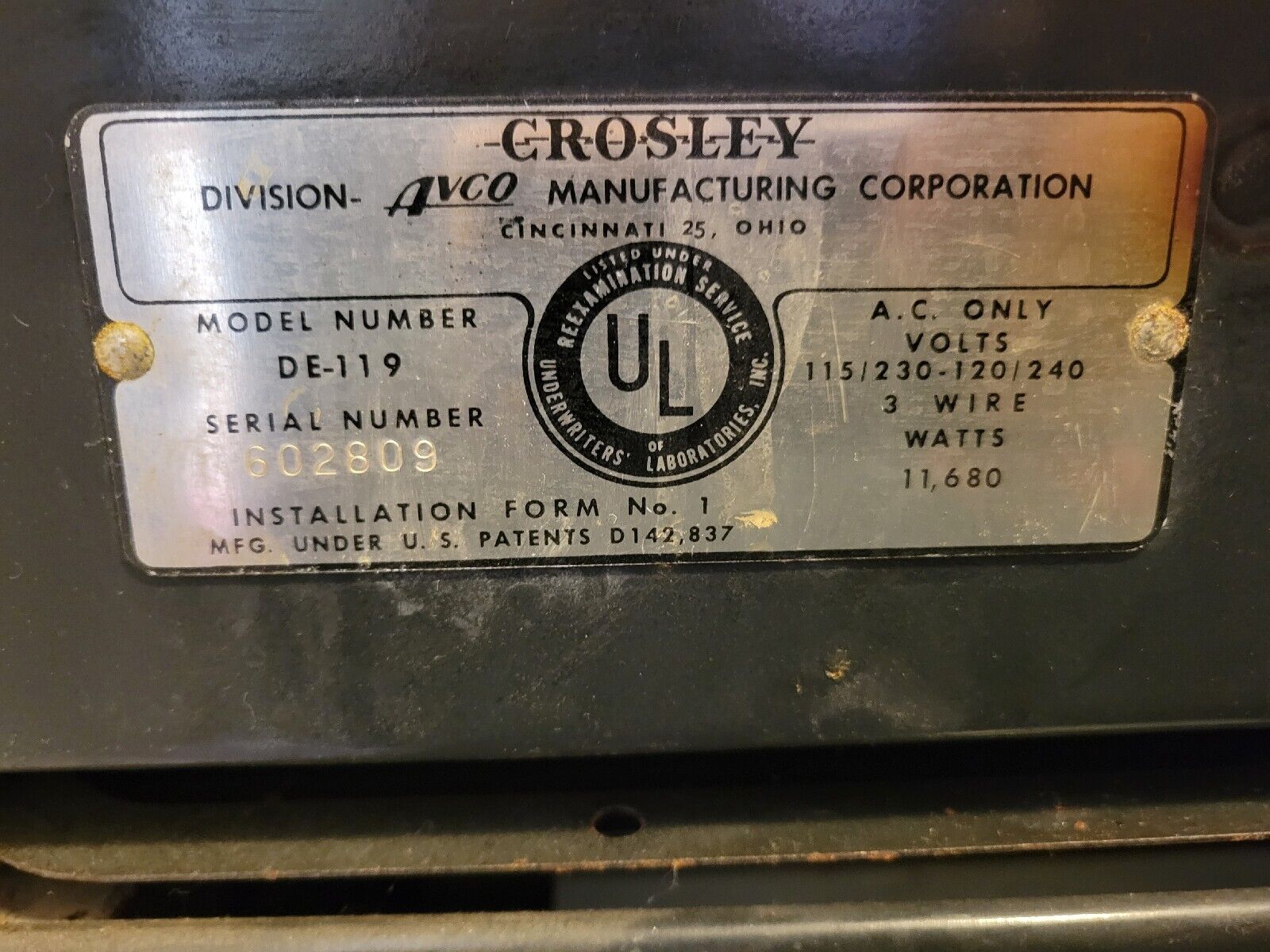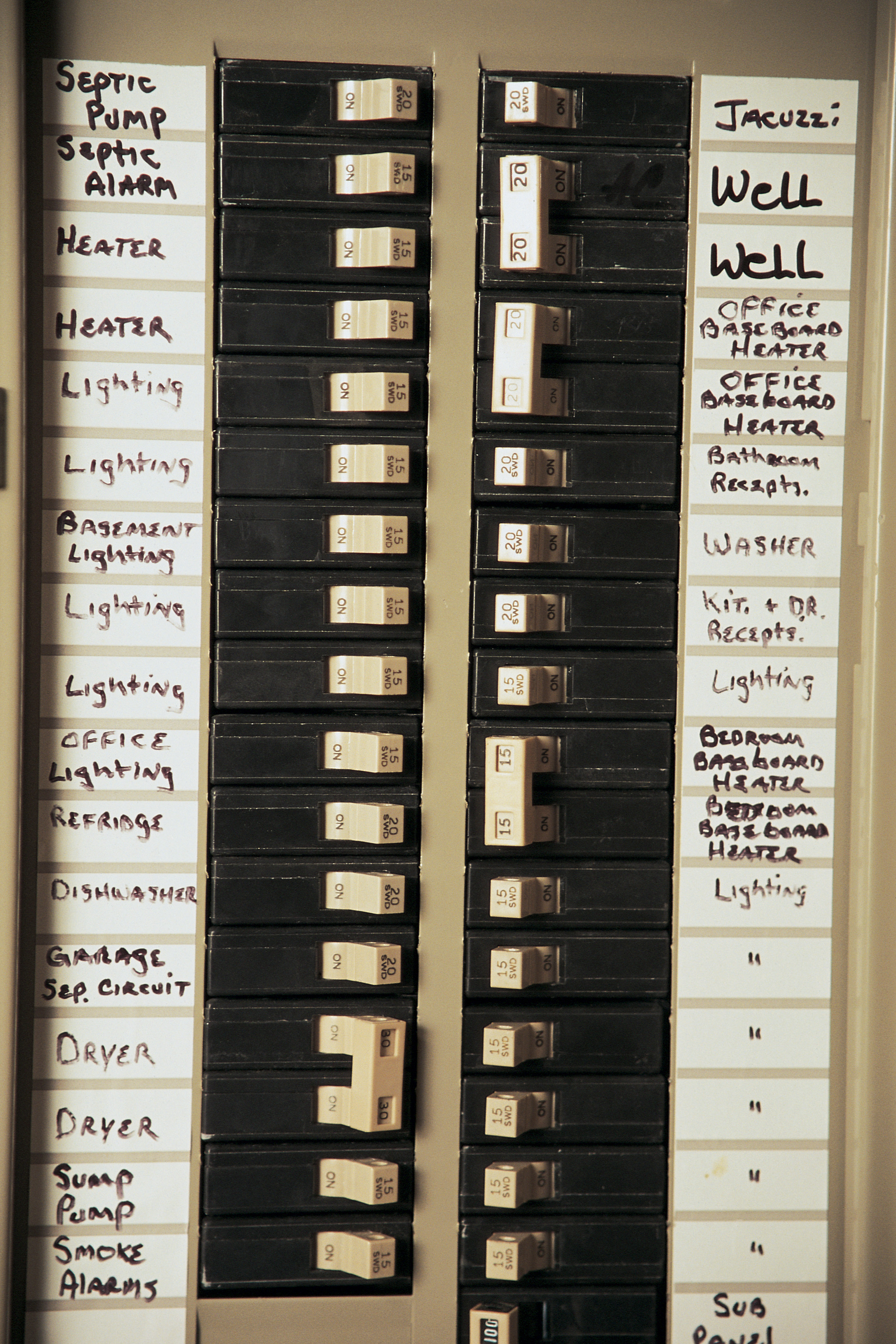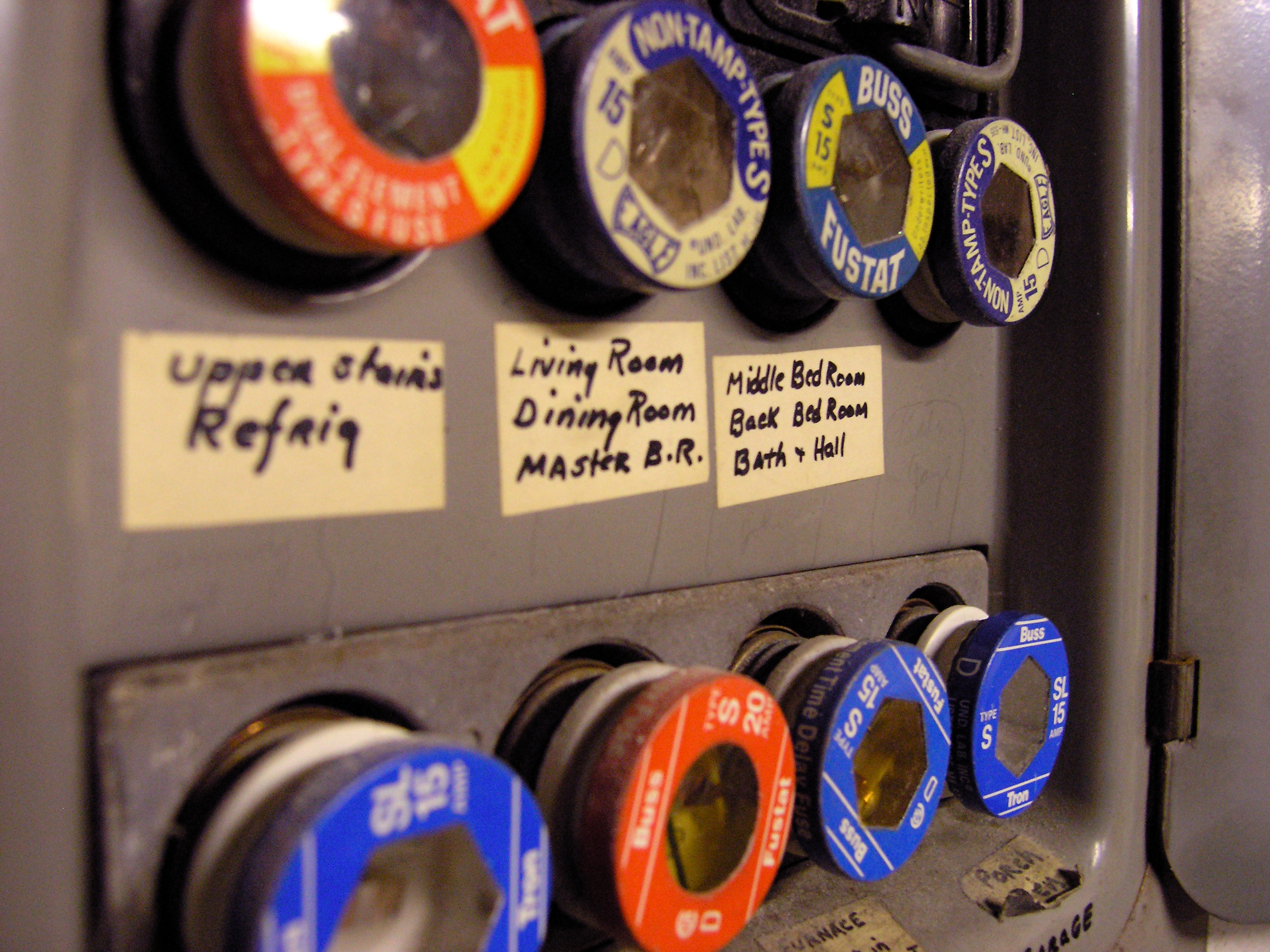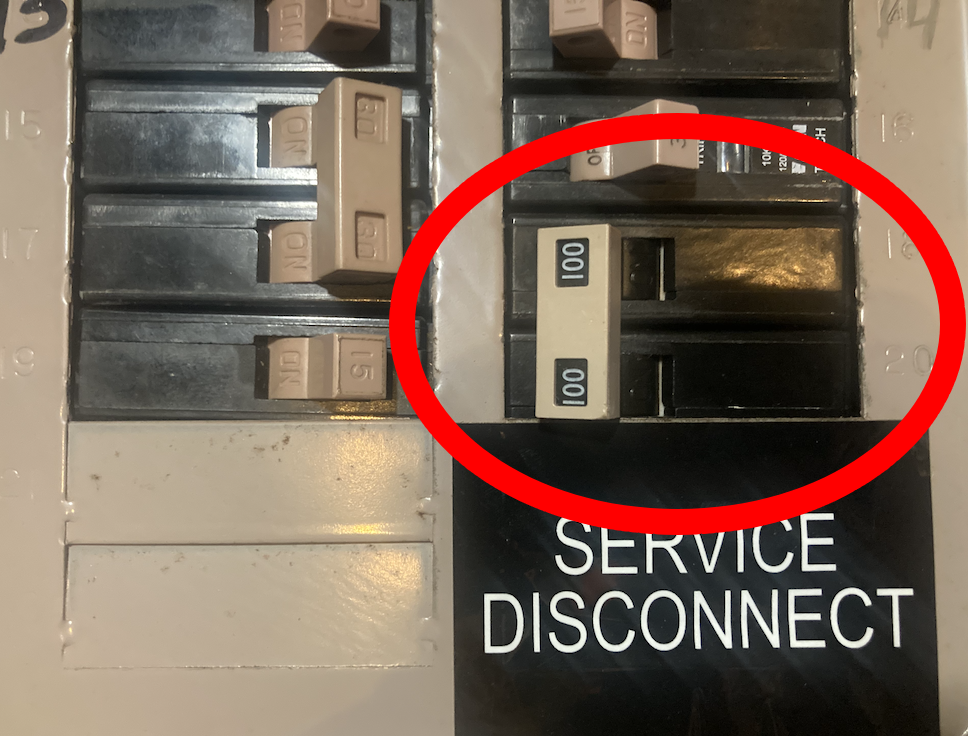Adding an EV or big appliance? You might not need a panel upgrade.
If you're switching appliances from gas to electric or adding an EV charger, you might assume that you need to upgrade your home's electrical panel. Often you don't need to, even if you have a 100 amp panel.
Are you electrifying your home by switching from gas to electric appliances, or adding large new load like an electric vehicle charger?
If so, you might assume that you need to upgrade your electrical panel to handle it all – or maybe an electrician has told you that you need to upgrade. While this will be true for many homeowners, you might be surprised to learn that even an old electrical panel can support a home with many appliances with high power needs, like induction cooktops or EV chargers.
Just because a panel is old doesn’t mean that it isn’t suited for modern appliances. High powered electrical devices aren’t new. For example, here’s the nameplate on a 1949s electric stove that I found on sale at eBay. The label indicates that it can draw 11,680 watts, which is 50 amps at 240 volts.

That’s about the same electrical requirements you might find on a modern induction range. While high power appliances aren’t new, what is new is the number of these appliances you can find in a modern home. Add enough of them together and you might start to run up against the limits of your existing panel.
According to HomeAdvisor, the average cost to upgrade an electrical panel is $1,274, but it can reach as high as $4,000 if you need to install a very large capacity panel. Any homeowner would hate to add an extra expense like this to a project. Fortunately, a panel upgrade is often unnecessary. Panels as small as 100 amps can have more than enough capacity for a fully electrified home.
Electricity can be an intimidating topic for a homeowner, but this guide will hopefully help you better understand the current state of your electrical panel and your existing and planned future loads so that you can make a wise decision about whether you really need to upgrade.
What exactly is an electrical panel?
Your home’s electrical panel performs a couple important functions. First, it distributes electricity to the individual wires – known as circuits – in your home. It also provides safety by protecting those circuits from overloading. When an appliance tries to draw more electricity than a circuit is designed to handle, the circuit breaker will automatically shut off or, in the case where the panel uses fuses, a wire in the fuse will melt and interrupt the flow of electricity. This prevents the wire from overheating and potentially causing a fire.

Electrical panels can also use more advanced circuit breakers that can detect ground faults and arc faults in the circuit, which could otherwise pose electrocution or fire hazards. These GFCI and AFCI circuit breakers can cost roughly $40-50 more than a standard circuit breaker, but add significant safety features.
Electricity enters your electrical panel though wiring from the utility company, known alternatively as the service feed, service conductors, or service drop. A utility meter will be attached to this feed to measure your electrical usage, and then from there the wiring will be routed into your panel.
In addition to your main electrical panel, you may have smaller sub-panels. An electrician may add a sub-panel when adding additional circuits to a home where the main panel has no more room.
To review our terminology:
- The electrical service, conductors or drop is the main bundle of wires from the utility company that provides electricity to your home. Often it will enter your home from a utility pole, which is why it’s sometimes called a drop: the wires drop from a high utility pole to your home. (Some homes do have underground service, however.)
- A round utility meter mounted near the electrical service records your home’s electricity usage for billing.
- The electrical panel is the rectangular enclosure that distributes electricity to circuits throughout your home, and protects those circuits with overcurrent devices – either circuit breakers or fuses.
A fuse box will probably need to be upgraded
If you have a fuse box like the one pictured below, you will probably need to replace it with an updated electrical panel with circuit breakers, and possibly with new wiring as well.

In addition to the common round fuses, you may find cylindrical fuses in a fuse box. These are often labelled “range” because they protect higher amp circuits, such as those for a kitchen. Even if you do have a circuit with a higher amp range fuse, your electrician will likely recommend upgrading your fuse box if you are installing a new induction stove. This is because induction stoves generally require a NEMA 14-50 outlet, and a circuit protected by a fuse box likely won’t have the wiring to support it.
In addition, if you have knob-and-tube wiring, you will need to upgrade it. Knob-and-tube is an obsolete type of wiring that was phased out in the 1940s. While knob-and-tube can still be safely used for low power applications such as lighting if the insulation is intact, it doesn’t have a ground wire (which is the third prong in modern household outlets in North America), which means that it doesn’t have an important safety feature that modern wiring does. For example, NEMA 14-50, which is a 240 volt, 50 amp outlet, requires a ground wire. Also, many home insurance providers will not insure homes that have knob-and-tube. (This is something I’ve experienced first-hand because my house was built in 1910.)
Knob-and-tube wiring is round and looks like this:

Identifying the size of your electrical panel
Fuse boxes are often limited to 60 amps, which is another reason why they will usually need to be upgraded.
Modern electrical panels with circuit breakers come in a few standard sizes in North America: 100, 150, 200, and 400 amps. New homes will tend to have 200 amp panels, while large homes with large electrical needs (such as a pool heater) may have 400 amp panels. You’ll find 100 amp and 150 amp panels in smaller and older homes.
You can identify the capacity of your panel by looking for the main breaker. It’ll be located at the very top, bottom, or sometimes the side of the other breakers in the panel. Here’s a photo from my panel:

You can see my large breaker labelled “100”, indicating that I have a 100 amp panel. The main breaker is a double pole breaker, which means that it occupies two slots and connects two hot wires for a total of 240 volts.
Keep in mind that the size of the main breaker may not always match the capacity of the panel or the size of the incoming electrical service. The main breaker might be smaller than the maximum capacity of the panel or the electrical service, but it should never be larger.
The capacity of the panel is determined by the busbars, which are thick metal bars hidden from view behind the circuit breakers. The electrical service is determined by the size of the wires entering your home.
If you need to upgrade your panel, it’s possible that your existing service will already have the capacity for additional load. If not, your utility company will need to upgrade the service line for a cost. On occasion, the utility’s transformer will need to be upgraded too. The utility company will usually pay for the transformer upgrade, but some may pass the cost onto the customer.
How much spare capacity does your electrical panel have?
If you have an electrical panel with empty slots and at least a 100 amp main breaker, there’s a good chance that you won’t need to upgrade your panel before adding additional electrical loads. Even if you don’t have empty slots, you might be able to have a subpanel added, which is a smaller panel that is branched from the main panel.
It’s a common misconception that the available capacity of an electrical panel is calculated by adding up the amperages of all the circuit breakers in the panel with a 20% safety margin included. In other words, this misconception states that if you have a 100 amp panel, you shouldn’t have more than 80 amps of breakers installed in the panel.
This is wrong! The National Electrical Code provides methods for calculating the size of the electrical service needed for a single or multi-family home. These calculations are based on the type and number of electrical loads, and not the total amperage of all the circuit breakers in a panel.
Because of the way the load calculation works, you could end up with an electrical panel where the sum of the circuit breakers is twice or more than the capacity of the main breaker. This means that a 100 amp panel might have 200 amps of circuit breakers installed. This is normal and not a safety issue! Remember that the individual circuit breakers protect individual circuits from overloading, and the main breaker protects the overall panel from overloading. As long as everything is correctly installed, this means that even if you turn on every major appliance in your home and exceed the limit of your panel, the main breaker will trip and turn off the power. Tripping a breaker in this scenario isn’t a safety hazard: it just means that you need to lower your power usage.
For example, the current NEC code specifies that a refrigerator should be on a dedicated 20 amp circuit. However, a large refrigerator might only use 6 amps of power while running. (If you’re wondering why the 20 amp requirement exists, it’s because appliances with motors will briefly draw a large surge of power when starting up. This brief inrush current is much higher than the steady-state current the appliance uses when operating.) This illustrates why adding up the circuit breakers in a panel isn’t the correct way to determine whether your panel is near capacity or not.
How to calculate your household electrical load
The National Electrical Code provides a choice of two calculations to determine the size of an electrical service for a home: the standard calculation 1 and a simplified optional calculation. Both use the concept of a demand factor, which makes an assumption about how often your appliances will actually be used.
Many homes will be able to use the easier optional calculation. The optional calculation assumes that the first 10,000 volt-amperes (VA) of loads in a home will have a demand factor of 100% (meaning that it’s assumed they’ll be on all the time), while the remaining loads will have a demand factor of 40% (meaning that they’ll be operating only 40% of the time).
For many loads, this already includes a generous safety margin. For example, a kitchen garbage disposal might use as much as 800 watts and be installed on a 20 amp circuit, but in practice a garbage disposal might operate for only a couple minutes a day on average.
While load calculations should always be done by a licensed electrician, you can try the optional calculation yourself if you want to get a general idea of whether you might need to upgrade your panel.
The calculator has some presets for typical appliances, and asks you to manually input the loads for any heating and air conditioning units. It suggests 6,000 VA for an average heat pump, but you can calculate it for your unit by looking up the RLA for the unit and multiplying it by 240 volts. Be sure to include the blower motor as well, which can be several hundred VA.
A side note about volt-amps, watts, and amps
Many people are familiar with watts, which is a measure of the rate of electricity usage, and amperes (amps), which measures the electric current. To use a garden hose analogy, you can think of amps as the diameter of the hose and watts as the volume of water flow.
Volt-amps (VA) are similar to watts. In fact, for some electrical devices they are the same. The difference is that VA is modified by the power factor2, which is the ratio of real power to the apparent power used by an appliance. Apparent power results from certain appliances such as electric motors and electronics that have capacitors, and reduce the efficiency of the appliance.
An appliance like an electric resistance heater will have a power factor of 1, meaning that real and apparent power are the same. However, electric motors will have a higher apparent power load, causing them to have a power factor of less than 1.
Volt-amps are calculated by dividing the wattage of the appliance (ie. the real power) by its power factor:
VA = W ÷ PF
As you can see, volt-amps will increase with lower power factors. For example, a 1,000 watt motor with a PF of 0.8 will draw 1,250 VA, while a motor with a PF 0.9 will draw 1,111 VA.
Fortunately, the compressors in modern heat pumps will typically have power factor correction to increase its efficiency. This means that a new heat pump will often have a PF around 0.98 or 0.99. This is something that has been observed in a study in Germany3.
The point of this side note is to explain that you can regard the VA rating of your heat pump or air conditioners to be approximately the same as watts, which is a more familiar electrical measure for many consumers. This will help you better understand the electrical calculations needed to determine if an electrical panel upgrade is needed.
Electrical loads of typical appliances
The previous section will help you better understand how much load you can expect from the appliances in your home because oftentimes appliance manufacturers will list VA ratings in their specifications.
| Appliance | Typical load | Typical circuit breaker |
|---|---|---|
| Clothes washer | 1,500 VA | 20A |
| Electric dryer | 5,000 VA | 30A @ 240V |
| Electric range | 11,000 VA | 60A @ 240V |
| EV charger | 7,200 VA | 50A @ 240V |
| Garbage disposal - 1/3 HP | 800 VA | 20A |
| Microwave | 1,500 VA | 20A |
| Dishwasher | 1,200 VA | 20A |
| Electric hot water heater | 4,500 VA | 25A @ 240V |
| Central AC/heat pump | 6,000 VA | 30A @ 240V |
There’s a few things to note about this table. First of all, these are just typical values, so if possible you should look up the specifications for your appliances.
Another is that kitchen appliances may or may not be on dedicated circuits, and in modern homes or renovations, kitchens circuits will be on 20A breakers. This means that even though a garbage disposal won’t max out the amperage on a 20A circuit, the circuit that it’s installed on may be shared with other high wattage appliances such as toasters and coffee makers.
Dishwashers and refrigerators are usually installed on dedicated circuits.
The last thing to note about this list is that heat pumps and central air conditioners will vary by size anywhere from 2 to 5 tons (or even more) in home installations, so the 6,000 VA figure cited here may not be representative of your home. Again, look up the manufacturer’s specifications for your appliance or use an energy meter to find out exactly how much electricity your appliances use.
New and old appliances will often have similar electrical loads
If you’ve already got electrical appliances in your home and want to upgrade them, don’t assume that you’ll also need to upgrade your wiring or electrical panel as well.
For example, I recently switched from a 30 year old central air conditioner to a heat pump. The old A/C operated on a 30 amp 240 volt circuit, which is the same that my new heat pump requires.
The same thing could be true if you’re upgrading an electric range. If you have a 4-prong (NEMA 14-50) plug for your current electric range, you’ll most likely won’t need to make any upgrades to install a new induction range. A NEMA 14-50 plug operates on a 50 amp circuit, which is adequate for all but the most high-end induction ranges on the market.
However, if you have an older 3-prong plug, it’s probably a 30 amp circuit, which may need to be upgraded depending on the model you choose. Some lower power induction cooktops only require 30 amps, while others are 40 amps. Cooktops are generally hardwired, which means that they are connected directly to the electrical circuit without the use of a plug, so the type of plug you have doesn’t matter. This means you can choose a 30 amp cooktop and have it wired into your existing 30 amp circuit, even though it has an older plug. However, electric ranges (which, again, include both a cooktop and oven) you buy today have NEMA 14-50 plugs, so the plug, circuit breaker, and probably the wiring will all need to be upgraded.
Smart monitors for your electrical usage
Another way of assessing the current electricity usage in your home is to install home energy monitoring devices. These range from simple $20 devices that plug into a single outlet and record real time electricity use and total energy usage over a period of time, up to whole-house monitoring devices that are installed into your electrical panel. This includes the popular Sense Energy Monitor, which starts at $300.
A home energy monitor is the best way to know whether you truly need to upgrade your electrical panel by showing you exactly how much electricity you use at any point in time. The Smart Monitor is able to identify appliances automatically by their particular electrical signal, so you don’t even need to program it to tell it which appliances are connected to which circuit.
The benefit of this, apart from giving you better insight into your electricity usage, is that if you do have enough electrical appliances that you are in danger of running up against the amperage limit of your panel, a monitoring system can help you change your when you use your appliances to reduce your peak load. For example, if you have an electric vehicle and typically plug it when you get home from work and then start cooking dinner on your electric range, a monitor can tell you whether you should instead be charging your car at night to reduce your load. (With EVs, in general should charge at night.)
In practice it’s hard to exceed the limit of your panel
Once you’ve done this analysis of your home - either by using a calculation like the standard or optional NEC methods described above, or an energy monitoring device - there’s a good chance that you’ll find that you’re in no danger of exceeding the limit of your electrical panel, even if it’s an older 100 amp panel like mine.
I have quite a few high amperage electrical devices in my home: a 24-amp EV charger, a heat pump, a stovetop induction burner, and the typical assortment of appliances like a toaster, microwave, dishwasher, and coffee maker. Even so, if I turned all of them on at the same time – I would still end up below the 100 amp capacity of my panel.
And what happens if I did exceed the limit? The worst thing that should happen is the main breaker of my panel would trip, temporarily knocking out power to my home. The solution to that is to simply turn off a few appliances and flip the breaker back on.
Bottom line: electrifying your home doesn’t automatically mean you need a panel upgrade
If you’re electrifying your home, one of the potential barriers is upgrading your home’s electrical panel, which will cost an average of $1,274 in the US according to HomeAdvisor. Obviously, that’s an added expense you’ll want to avoid if possible.
There are clear cases when an upgrade is needed, such as old fuse-based panels when can be as small as 50 amps, knob-and-tube wiring, and other safety hazards that your electrician may identify.
However, a small 100 amp panel isn’t necessarily a barrier to adding new electrical appliances to your home. Electricians may sometimes make an assumption that your panel needs to bigger, but make sure they do a proper load calculation of your home before they have you spend a thousand dollars or more on a panel upgrade that you don’t need.
References
Article 220 of the National Electrical Code - Branch-Circuit, Feeder, and Service Calculations (PDF): https://site.ieee.org/icps-ehe/files/2015/11/13-9-NFPA-70_-National-Electrical-Code-NEC-Article-220.pdf ↩︎
Explanation of power factor (WikiPedia) https://en.wikipedia.org/wiki/Power_factor ↩︎
Dataset on electrical single-family house and heat pump load profiles in Germany https://www.nature.com/articles/s41597-022-01156-1 ↩︎



